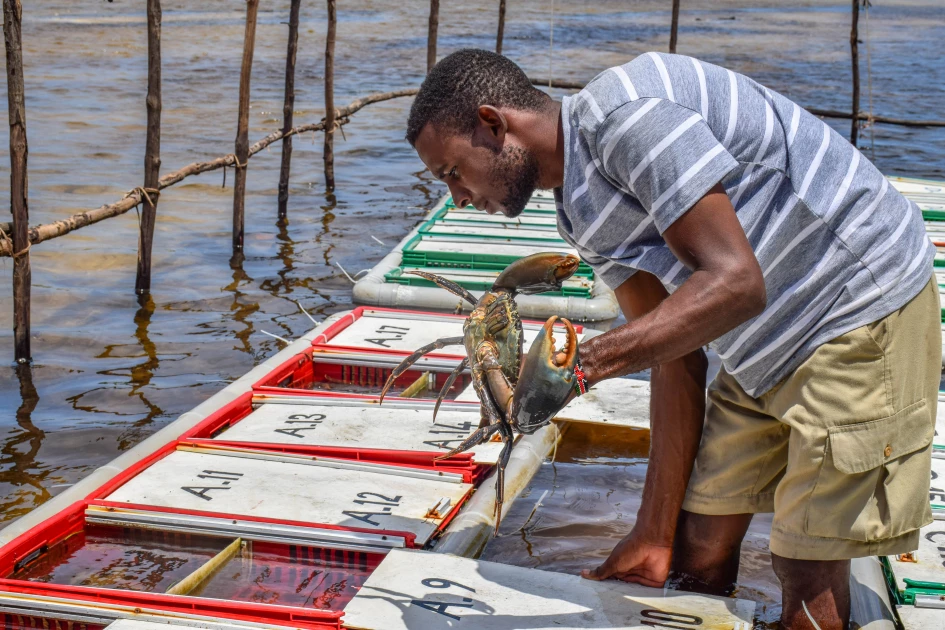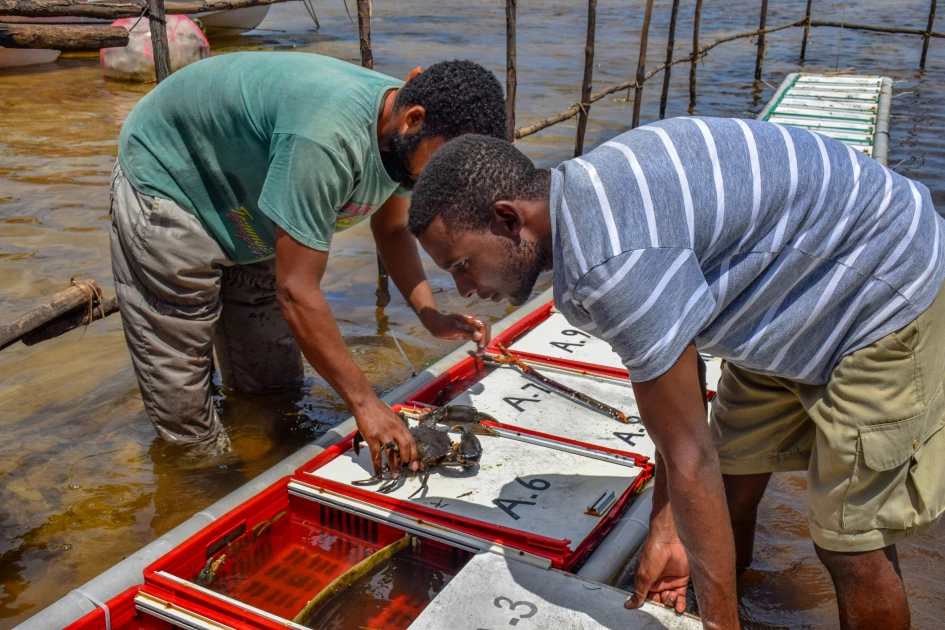Mangroves Treasures: Pate Islands mud crab fattening boom brings new hope for fishermen

Hajj Ramadhan of PRATI attends to mud crabs, part of PRATI's livelihood activity.

Audio By Vocalize
He used to spend endless hours on his boat, skimming the salty waters of the Indian Ocean, searching for his crustacean prey in the fish-rich areas of Pate, Manda, and Lamu islands, which make up the larger Lamu archipelago.
With the invaluable guidance of Wetlands International aquaculture specialists, Abdalla undertook a pioneering initiative in July last year: the cultivation of giant mud crabs.
With this endeavor, he hoped to outperform the meager returns from his old-fashioned crab hunts, which frequently produced only one catch per day. For the new venture, however, he was to buy crablets.
In mud crab fattening aquaculture, crablets are caught, caged, and fed to maturity for sale. Mud crabs are primarily abundant in the Pacific and Indian Ocean mangrove swamps and estuaries. The crustacean has excellent aquaculture potential and is slowly attracting fishermen along the coastline.
“Growing up, my father was a fisherman, and these skills have been passed down to me. He would equally go hunting crabs, but was a skilled fisherman,” he says, adding that the mud crab fattening is in response to diminishing fish catch in the sea.
What drives him? Simple. There has been an increase in restaurant patronage due to the delicacy, particularly for female crabs due to their large orange-red egg masses, and myths about its aphrodisiac properties. One evening at a time, he has been topping off his clients' plates with a crab.
“I was inspired when I visited Crab Shack Dabaso in Mida Creek in Watamu. On returning, I informed my fellow fishermen, and we approached Wetland International for cages. Since July, we’ve bought and caged 200 mud crabs, and some have grown to weigh up to 1.5 kilograms,” Abdalla says.
Through seeding capital from Pate Restoration and Tourism Initiative (PRATI), a thirty-member group based in Pate and dedicated to mangrove restoration and beekeeping, Abdalla is turning the crabs’ dwindling tides. He slowly nods, mentioning his clientele—well-heeled tourists who readily pay between Sh2,400 and Sh2,800 a kilo.
“Here on Pate Island, our PRATI group is leading the pilot project for fattening mud crabs. We give the crabs three to four days off after they molt before we start feeding them again so they can grow to the proper size," he says.

The main feed for the crabs is palm-sized fish sourced from fishermen who sell it to them for refrigeration at their store. They buy the feed in batches of 20 to 40 kilograms and stock it for a week’s use.
Abdalla's group, which is spearheading the crab fattening project, has opened a new stream of cash flow. A near-crumbling building protrudes from the sea just west of their mud crab fattening site.
Their once lively restaurant has remained a shell. Currently supported by rotting mangrove poles, the group's goal is to restore the joint.
"We want to fully operationalize the structure on the west side, which is our property. The group's 35-year-old volunteer crab feeder, Mohammed Ali Swaleh, says, "We are prioritizing serving our restaurant guests with our crabs, but the exporting business will continue."
The group has learned lessons for its delicate business from the strange diseases, the recent collapse of the Kenyan shilling against the US dollar, and the crab deaths caused by poor site selection.
"After discovering that poor site selection contributed to the crab's demise, we moved. Furthermore, Mohammed adds, "We have encountered issues with illnesses that cause the notches and abdomen regions of crabs to swell but ultimately disappear on their own, particularly after molting."
According to the UN's Food and Agriculture Organization’s (FAO) mud crab fattening aquaculture practical manual, disease vigilance is important, prohibiting human consumption of crabs that are found dead in sea waters.
“For the staff, their movements should be restricted to only those areas they need to visit for their duties. If staff must move between different units of a farm, the use of facilities to wash hands and footwear between areas can be used to reduce the risk of disease transfer,” FAO recommends in the manual.
Wetlands International says the project is aimed blending community cultural belief, especially food, to engage locals in the restoration of mangroves. Mud crabs, just like fish, hatch in saline-muddy areas.
“Mud crab fattening is a climate action initiative in response to rising sea levels, which have had an impact on the fish stock,” says Shawlet Cherono, a project officer at Wetlands International working in Lamu.
She adds that the group, which has qualified for the World Bank’s Financing Locally-Led Climate Action Program (FLLoCA) fund, is aiming at investing in a restaurant.
“We are working with the community to see to it that we help them understand the challenges associated with mud crab fattening, and as such, we want them to prepare a stock for their guests, so that when we revitalize their entertainment, they have enough stock for guests,” Mrs. Cherono says.
A study conducted by FAO shows that mud crabs have high levels of calcium, iron, and potassium. Incorporating mud crabs into a balanced diet can contribute to improved heart health, enhanced immune function, and overall nutritional well-being, the study explains.


Leave a Comment